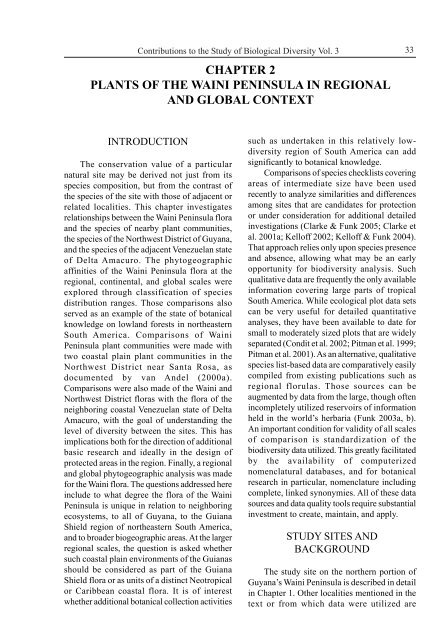Plant Community Structure, Fire Disturbance, and Recovery in ...
Plant Community Structure, Fire Disturbance, and Recovery in ...
Plant Community Structure, Fire Disturbance, and Recovery in ...
Create successful ePaper yourself
Turn your PDF publications into a flip-book with our unique Google optimized e-Paper software.
Contributions to the Study of Biological Diversity Vol. 3<br />
CHAPTER 2<br />
PLANTS OF THE WAINI PENINSULA IN REGIONAL<br />
AND GLOBAL CONTEXT<br />
INTRODUCTION<br />
The conservation value of a particular<br />
natural site may be derived not just from its<br />
species composition, but from the contrast of<br />
the species of the site with those of adjacent or<br />
related localities. This chapter <strong>in</strong>vestigates<br />
relationships between the Wa<strong>in</strong>i Pen<strong>in</strong>sula flora<br />
<strong>and</strong> the species of nearby plant communities,<br />
the species of the Northwest District of Guyana,<br />
<strong>and</strong> the species of the adjacent Venezuelan state<br />
of Delta Amacuro. The phytogeographic<br />
aff<strong>in</strong>ities of the Wa<strong>in</strong>i Pen<strong>in</strong>sula flora at the<br />
regional, cont<strong>in</strong>ental, <strong>and</strong> global scales were<br />
explored through classification of species<br />
distribution ranges. Those comparisons also<br />
served as an example of the state of botanical<br />
knowledge on lowl<strong>and</strong> forests <strong>in</strong> northeastern<br />
South America. Comparisons of Wa<strong>in</strong>i<br />
Pen<strong>in</strong>sula plant communities were made with<br />
two coastal pla<strong>in</strong> plant communities <strong>in</strong> the<br />
Northwest District near Santa Rosa, as<br />
documented by van Andel (2000a).<br />
Comparisons were also made of the Wa<strong>in</strong>i <strong>and</strong><br />
Northwest District floras with the flora of the<br />
neighbor<strong>in</strong>g coastal Venezuelan state of Delta<br />
Amacuro, with the goal of underst<strong>and</strong><strong>in</strong>g the<br />
level of diversity between the sites. This has<br />
implications both for the direction of additional<br />
basic research <strong>and</strong> ideally <strong>in</strong> the design of<br />
protected areas <strong>in</strong> the region. F<strong>in</strong>ally, a regional<br />
<strong>and</strong> global phytogeographic analysis was made<br />
for the Wa<strong>in</strong>i flora. The questions addressed here<br />
<strong>in</strong>clude to what degree the flora of the Wa<strong>in</strong>i<br />
Pen<strong>in</strong>sula is unique <strong>in</strong> relation to neighbor<strong>in</strong>g<br />
ecosystems, to all of Guyana, to the Guiana<br />
Shield region of northeastern South America,<br />
<strong>and</strong> to broader biogeographic areas. At the larger<br />
regional scales, the question is asked whether<br />
such coastal pla<strong>in</strong> environments of the Guianas<br />
should be considered as part of the Guiana<br />
Shield flora or as units of a dist<strong>in</strong>ct Neotropical<br />
or Caribbean coastal flora. It is of <strong>in</strong>terest<br />
whether additional botanical collection activities<br />
33<br />
such as undertaken <strong>in</strong> this relatively lowdiversity<br />
region of South America can add<br />
significantly to botanical knowledge.<br />
Comparisons of species checklists cover<strong>in</strong>g<br />
areas of <strong>in</strong>termediate size have been used<br />
recently to analyze similarities <strong>and</strong> differences<br />
among sites that are c<strong>and</strong>idates for protection<br />
or under consideration for additional detailed<br />
<strong>in</strong>vestigations (Clarke & Funk 2005; Clarke et<br />
al. 2001a; Kelloff 2002; Kelloff & Funk 2004).<br />
That approach relies only upon species presence<br />
<strong>and</strong> absence, allow<strong>in</strong>g what may be an early<br />
opportunity for biodiversity analysis. Such<br />
qualitative data are frequently the only available<br />
<strong>in</strong>formation cover<strong>in</strong>g large parts of tropical<br />
South America. While ecological plot data sets<br />
can be very useful for detailed quantitative<br />
analyses, they have been available to date for<br />
small to moderately sized plots that are widely<br />
separated (Condit et al. 2002; Pitman et al. 1999;<br />
Pitman et al. 2001). As an alternative, qualitative<br />
species list-based data are comparatively easily<br />
compiled from exist<strong>in</strong>g publications such as<br />
regional florulas. Those sources can be<br />
augmented by data from the large, though often<br />
<strong>in</strong>completely utilized reservoirs of <strong>in</strong>formation<br />
held <strong>in</strong> the world’s herbaria (Funk 2003a, b).<br />
An important condition for validity of all scales<br />
of comparison is st<strong>and</strong>ardization of the<br />
biodiversity data utilized. This greatly facilitated<br />
by the availability of computerized<br />
nomenclatural databases, <strong>and</strong> for botanical<br />
research <strong>in</strong> particular, nomenclature <strong>in</strong>clud<strong>in</strong>g<br />
complete, l<strong>in</strong>ked synonymies. All of these data<br />
sources <strong>and</strong> data quality tools require substantial<br />
<strong>in</strong>vestment to create, ma<strong>in</strong>ta<strong>in</strong>, <strong>and</strong> apply.<br />
STUDY SITES AND<br />
BACKGROUND<br />
The study site on the northern portion of<br />
Guyana’s Wa<strong>in</strong>i Pen<strong>in</strong>sula is described <strong>in</strong> detail<br />
<strong>in</strong> Chapter 1. Other localities mentioned <strong>in</strong> the<br />
text or from which data were utilized are
















